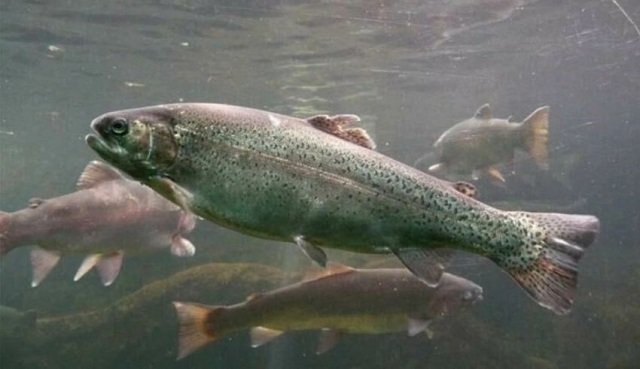
Raising Atlantic salmon (Salmo salar) on offshore farms exposes them to a dual challenge: sea lice and infectious viruses. These threats not only directly harm the fish but can also weaken their immune systems, making them even more susceptible to diseases.
Traditionally, salmon farmers have relied on treatments such as vaccines and medicinal baths to combat these problems. However, researchers are exploring a new frontier: functional feed.
Scientists from the University of Prince Edward Island (Canada), Cargill Innovation Center (Norway), Fisheries and Oceans Canada, and the Institute of Marine Sciences Bergen (Norway) investigated how different dietary modifications affect salmon’s response to co-infections with sea lice (Lepeophtheirus salmonis) and infectious salmon anemia virus (ISAv).
A new hope: functional foods
The research explores a groundbreaking approach: dietary intervention. The scientists investigated whether specially formulated feeds containing specific nutrients could:
- Boost salmon’s natural defenses against sea lice and ISAv.
- Mitigate the negative effects of co-infection (having lice and the virus simultaneously).
The power of omega-3s
Previous research suggests that diets rich in specific fatty acids can enhance salmon’s antiviral response. The study aims to leverage those findings and explore the potential for broader immune support.
The research team tested four different diets:
- Control diet: Low in omega-3 fatty acids (EPA/DHA) and high in omega-6 fatty acids.
- FA+I diet: Enriched with EPA/DHA and designed to promote inflammation, a key part of the immune response.
- FA-I diet: Enriched with EPA/DHA but formulated to reduce inflammation.
- Ctrl+IS diet: Low in EPA/DHA but supplemented with an immunostimulant.
Interestingly, the diets enriched with these fatty acids (FA+I and FA-I) seemed to help control sea lice abundance in fish infected only with lice. However, the story becomes more complex with co-infections.
Immune response
While the enriched diets reduced the number of lice, they also triggered a strong upregulation of antiviral genes in the salmon’s immune system. This suggests that the fish were prioritizing the lice threat, potentially leaving them vulnerable to the virus.
Stay Always Informed
Join our communities to instantly receive the most important news, reports, and analysis from the aquaculture industry.
The scientists analyzed the fish’s gene expression to understand the underlying mechanisms. They found that diets other than the immunostimulant (Ctrl+IS) caused a significant increase in the activity of genes associated with the interferon antiviral system. However, in fish fed diets that successfully reduced lice levels (FA+I and Ctrl+IS), high levels of these antiviral genes coincided with high viral and lice loads.
The trade-off: lice versus virus
The study revealed a possible trade-off between lice resistance and viral defense. Diets effective against lice were not as successful in protecting fish co-infected with lice and a virus. This highlights the need for a nuanced approach to developing functional feeds.
Conclusion: a nutritional balancing act
This study underscores the intricate relationship between diet, immunity, and parasite resistance in salmon. While specific dietary components showed promise in controlling sea lice, they may come at the cost of increased viral susceptibility.
The study’s conclusions can be summarized as:
- No impact on growth: Functional feeds did not affect the growth rate or overall health of the salmon.
- Reduced feed intake: Fish co-infected with lice and the virus showed lower feed intake compared to those with only lice infection.
- Lower lice counts: Functional feeds, particularly those high in omega-6 fatty acids, led to lower lice counts in infected fish.
- Mixed effects on ISA virus: Functional feeds showed some potential to reduce viral replication, but overall mortality rates remained similar across diets.
- Immune system response: Some functional feeds stimulated the expression of genes associated with the antiviral response, but this did not necessarily translate to better survival.
- Wound healing versus antiviral response: Diets promoting wound healing (high in omega-6) might have compromised the fish’s ability to combat the virus.
Further research is essential to identify optimal feed combinations that can effectively combat both lice and viruses. This will involve carefully tailoring diets based on expected co-infection challenges. Ultimately, this research paves the way for developing targeted nutritional strategies to promote healthier and more resilient salmon populations in aquaculture.
The study was part of the Integrated Pathogen Management of Q22 Co-infection in Atlantic Salmon (IPMC) project (Genomic Applications Partnership Program), funded by the Government of Canada through Genome Canada and Genome Atlantic. The project was also funded by Mitacs (through the Mitacs Accelerate program), EWOS Innovation/Cargill Aqua Nutrition, and the SFI-Sea Lice Research Center.
Contact
Mark D. Fast
Department of Pathology and Microbiology, Atlantic Veterinary College, University of Prince Edward Island
550 University Avenue, Charlottetown, PE, C1A4P3, Canada.
Email: mfast@upei.ca
Reference (open access)
Carvalho, L. A., Whyte, S. K., Purcell, S. L., Hay, T., Taylor, R. G., Balder, R., Gagné, N., Dalvin, S., & Fast, M. D. (2024). The impact of functional feed on Atlantic salmon (Salmo salar) systemic immune response to high and low levels of sea lice infection (Lepeophtheirus salmonis) and co-infection with infectious salmon anemia virus. Comparative Immunology Reports, 6, 200147. https://doi.org/10.1016/j.cirep.2024.200147
Editor at the digital magazine AquaHoy. He holds a degree in Aquaculture Biology from the National University of Santa (UNS) and a Master’s degree in Science and Innovation Management from the Polytechnic University of Valencia, with postgraduate diplomas in Business Innovation and Innovation Management. He possesses extensive experience in the aquaculture and fisheries sector, having led the Fisheries Innovation Unit of the National Program for Innovation in Fisheries and Aquaculture (PNIPA). He has served as a senior consultant in technology watch, an innovation project formulator and advisor, and a lecturer at UNS. He is a member of the Peruvian College of Biologists and was recognized by the World Aquaculture Society (WAS) in 2016 for his contribution to aquaculture.




